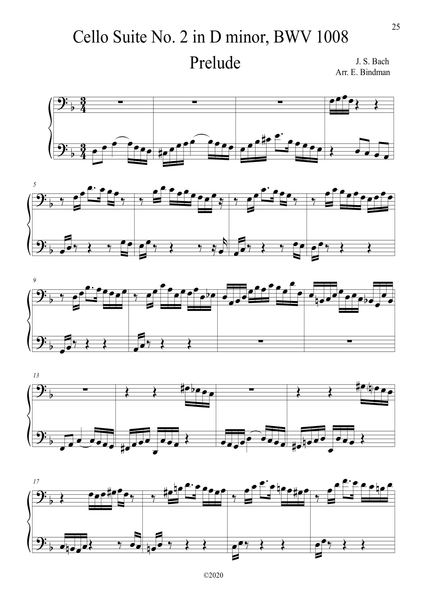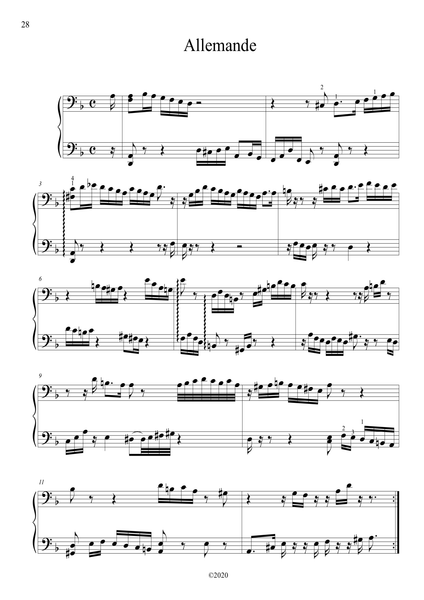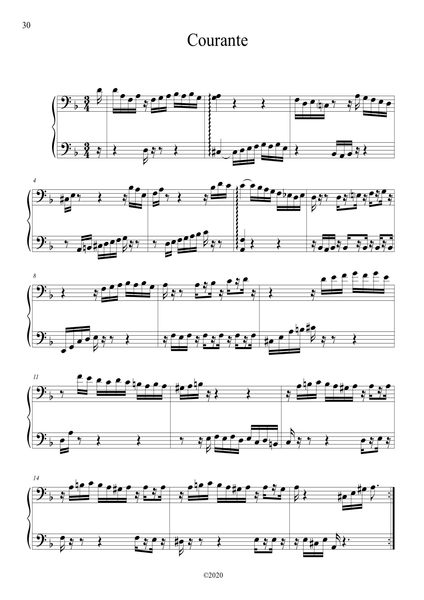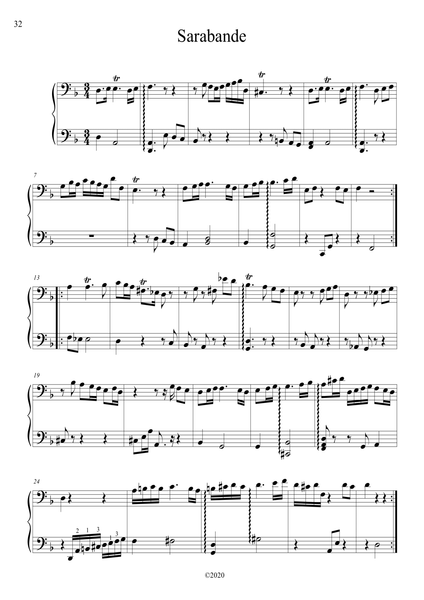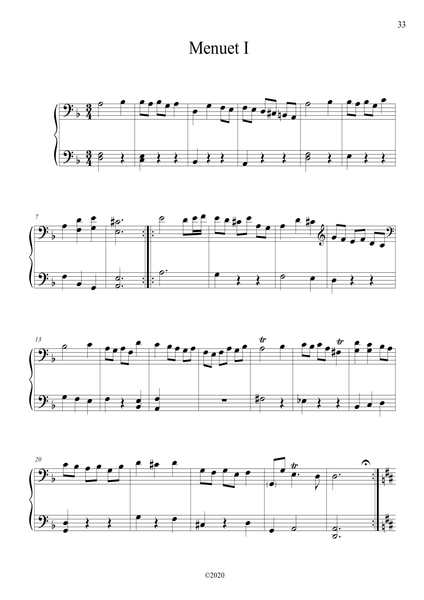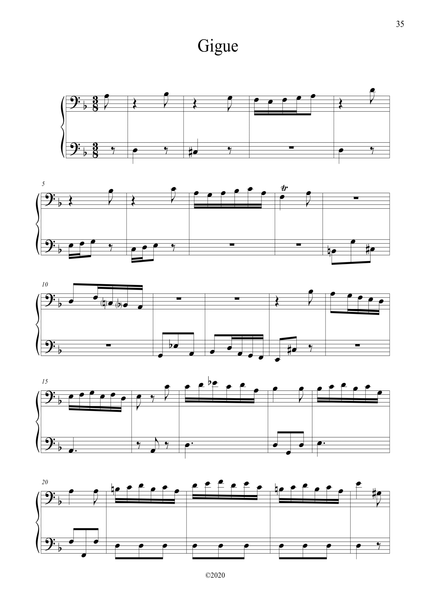J.S. Bach: Cello Suite No. 2 in D minor, BWV 1008 – arranged for piano by Eleonor Bindman (GPC076)
This is the sheet music edition of a new piano arrangement of the Bach Cello Suite No. 2 in D minor by Eleonor Bindman.
Solo piano
13 pages
Duration: 19:35
Audio samples
Buy, stream and download the CD here.
The second Suite dwells in a very different emotional realm than the first: instead of growth, we now have introspection. The Prelude feels like a search in the darkness, a series of questions without answers. It reminds me of Auguste Rodin’s sculpture “The Thinker:” a man, dark gray, deep in thought and resigned to fate.
The D Minor triad – our unifying element which starts every movement, except Minuet II and the Gigue – tentatively reaches up in the first three notes of the Prelude. It rolls back immediately toward a C# and then tries to ascend again, this time to a diminished 7 , then rolls back to start a third, even wider climb of an octave. (A similar pattern of three expanding waves is later used in the left-hand theme of Chopin’s Prelude Op. 28 No. 6 in B minor, creating an equally dramatic effect). The three questions are expanded in mm. 5-12 into two-measure units and then we arrive into F major, the relative key, in m. 13. The first “triad” question is repeated, then the second one. Then we have an unfolding with three increasing ascending phrases in mm. 17-19, all with the longest note on the second beat. Just like in the beginning, this “stop” in the middle of a measure creates a sense of hesitation, indecision. Bach continues, increasing tension in a recitative style, to a dominant chord in m. 48 which clearly stops the motion for the first time. After the fermata, an unexpected Eb major measure continues our journey toward the end. In the manuscripts, the last five measures of this Prelude have long blocked chords but many cellists arpeggiate them in 16th notes. I chose to do so as well, since it feels awkward to stop the momentum built up in mm. 55-58. I start the pattern from the top, so the upper notes C#, D, D and C# may carry the melodic continuity started by the Eb and D in m. 58. In the score, I wrote out the arpeggios in the right hand and the blocked chords are in the left so you may choose which you prefer to play. The style of this Prelude encourages broad rubato but the approximate tempo in 16th-note passages should be 50 per quarter note.
The Allemande seems straightforward and robust after the probing Prelude. An interesting 32nd-note run in m. 9 interrupts the consistent rhythm only once, hinting at a slightly slower overall tempo, around 72, and maybe at a possibility for similar rhythmic embellishment upon repeat. To offset the following movement, this one should be relatively loud overall.
The rhythmic texture of the Courante is similar to that of the Allemande, so we must highlight the differences: a strong downbeat of a 3/4 time signature, a faster tempo (90?) and a lighter, somewhat hollow-feeling touch, imitating a harpsichord. Each half starts and ends with arpeggiated chords which I like to sustain slightly, even using the pedal for repeats. There’s clearly implied counterpoint in mm. 7, 9, 13-16, 25 and 27-end. The preferable overall dynamic here would be piano to mezzo piano.
In the Sarabande, we return to a gray mood. Mstistlav Rostropovich described this movement as “very, very sad” and my inclination is to play it “sotto voce.” It has the same prolonged notes on the second beats as the Prelude, reducing momentum. F major brings warmer emotions in mm. 9-12 but this hopeful start to the second half quickly gives away to contrapuntal, descending “sighs” in mm. 17- 18, returns to D minor in 21-24 and ends after an intense and chromatic ascent in 25-28. The build-up in the last four measures allows for a strong ending, but can also be interpreted with a diminuendo and ritardando, an exhausted resignation to fate.
Menuet I echoes the Sarabande in its mood, somewhat muted emotionally, as if dancing in a distant dream. This is one movement where the soft pedal can be used for repeats if not throughout. By necessary contrast, Menuet II in the parallel major key brings to mind Schumann’s “Happy Farmer” from Scenes of Childhood and doesn’t require much of an interpretive effort as long as it’s played loudly and in strict tempo – both Menuets sound good at 120 per quarter note. When returning to Menuet I, it works well to transpose both hands up an octave in mm. 22-24 for an interesting ending.
The Gigue, with its decisive beginning and fast-and-steady 3/8 meter is by far the most energetic movement in the two Suites we’ve had so far. The descending perfect 5th (A-D) and diminished 7th (Bb-C#) of measures 1-2 are the connection to the Prelude, an inversion of the first two “questions.” There is a continuous presence of a 16th-note pattern, first found in m. 15 and repeated in 17, 19, 21-23, 25-28, 49-51, 53-55, 61-64 and 69-71, which gives this movement an almost manic character, further punctuated by repeated bass notes in mm. 21-23 and 69-71. I play those bass notes as alternating octaves during the repeats, which would be impossible on the cello but is often done in the left hand of Bach’s keyboard works. This movement sounds good either at a moderate or a very fast tempo, I enjoy letting it take over in a devilish frenzy, to counterbalance the rest of the Suite, with the final effortless two-octave arpeggio triumphing over the initial tentative triad of this Suite.
– Eleonor Bindman







